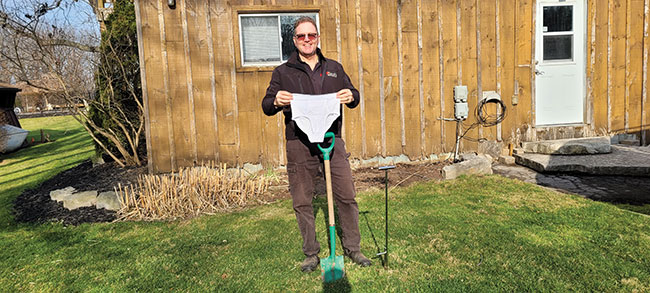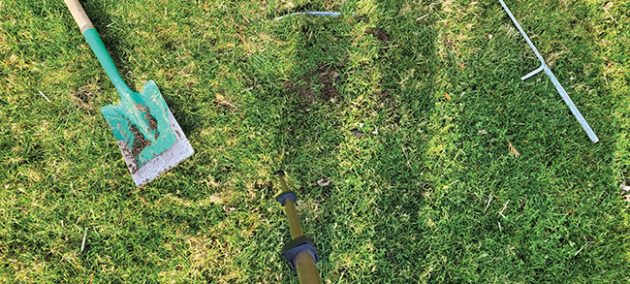
Features
Earth Week
Eco-Friendly Soils
‘Soil Your Undies’ to better understand how biology works
Lawn care professional says initiative will show just how active microorganisms are in the soil
February 12, 2021 By Mike Jiggens
 St. Catharines, Ont. lawn care professional Michael Stangl prepares to bury a pair of cotton underwear into the soil to gauge the amount of microbial activity beneath the surface.
St. Catharines, Ont. lawn care professional Michael Stangl prepares to bury a pair of cotton underwear into the soil to gauge the amount of microbial activity beneath the surface. A St. Catharines, Ont. lawn care professional is challenging other companies and consumers to “Soil Their Undies” this spring during National Soil Conservation Week, April 25 to May 2. The initiative of the Soil Conservation Council of Canada encourages participants to bury a pair of 100 per cent cotton briefs into the soil for two months and then examine the level of the underwear’s decomposition.
Michael Stangl, owner of Stangl’s Enviro Lawn Care, is encouraging others in the industry to bury two pairs of briefs in the same general area – one to be extracted after 30 days and the other to be recovered after 60 days.
The Soil Conservation Council of Canada suggests the underwear be buried within the top six inches of soil with the top part of the waistband still showing. At the end of the prescribed intervals, the underwear should be retrieved from the ground and placed in a bucket of water to remove any remaining soil. If nothing much of the underwear’s material is left, it will indicate a healthy soil with plenty of biological activity happening.
Stangl got a head start on his own involvement in the “Soil Your Undies” initiative by burying six pairs of underwear in December, not only on his own home lawn but in other areas including a regen market garden and orchard.
“We’re going to show how biology grows and works all winter long by the breakdown of the underwear,” he said.
The underwear he buried were to be retrieved about Feb. 10 so that the results could be shared at the Innovative Farmers’ Association of Ontario’s virtual conference, Digging Deeper, Feb. 16-19 at which he is speaking.
The proponent of regenerative lawn care previously took soil samples from each underwear burial site to determine the populations of such organisms as protozoa, nematodes and microarthropods, and also determined the soil’s biomass ratio of fungus to bacteria.
He said turfgrass is more of a fungal plant with a one-to-one ratio with bacteria. If there is more weight among the bacteria, the soil will be a more anaerobic, higher nitrate system that flushes up more weeds.
“That’s what our lawns are. We have a bacterial-dominant compacted dirt that flushes up weeds because when spring comes along and the bacteria starts getting active, naturally you wouldn’t have as much nitrate available, but when we pump on fertilizer, we excite that bacteria and in return get a breakdown in the carbon in the soil – the organic matter – and it comes up as carbon dioxide, but the plant is picking up all these minerals and nutrients because now the bacteria is eating, eating, eating. The plants are absorbing it.”
Stangl said no one needs to be a scientist to fully understand what is happening in the soil, but noted it’s important to realize that weeds grow due to an imbalance of life within the soil.
“It’s not growing to compete with the grass. It’s growing to get the biology and soil health father ahead so we don’t have to use chemicals. The plant diversity we call weeds is going to be part and parcel of landscapes. We keep spraying with products and still come up with the same problem.”
Rhizosphere microbiome
The science of the rhizosphere microbiome within the past 10 years has risen significantly, he said, and it’s harder to blame the weather anymore for turf problems.
“What happens with the weather is an issue or outcome from what we’re doing to the land. What’s happening with the weather is caused by what we’re doing on the lawn.”
When he began his career in lawn care in 1981, Stangl said he sprayed chemical products five days a week, covering 100,000 square feet daily, and returned home at the end of the day feeling woozy, even though he was otherwise healthy. That prompted him to further his education to see how he could still effectively maintain lawns without having to rely on so much product. As a result of his stepped-up education, he said he realized that what he was doing to the soil was the cause of weed growth, noting that the destruction of life in the soil was causing it to collapse to compaction. He said each microgram of nitrogen added to the bacteria eats five micrograms of organic matter, and that’s what causes grass to grow so quickly.
“It looks good, but it’s not a healthy plant at the end of the day.”
The turf is rendered more susceptible to drought, heat, disease and insects, he said.
Stangl said lawn care professionals are stewards of lawns and plants and should be producing a healthy soil and eco system for all. The regenerative lawn care process allows the soil to improve over time, resulting in a self-perpetuating regenerative cycle where worm populations are at about 25 per cubic foot. He added the process allows for reduced inputs that lead to increased profits. The process also allows carbon to build within the soil while conventional lawn care burns it off, he said.
His lawns and sports fields have sequestered more than 60 tons of carbon dioxide, reducing the effect of climate change.
Stangl said it’s been a challenge to sell the concept of regenerative lawn care to potential customers, but noted many lawn care companies end up returning to their customers’ properties to apply more product to keep them appeased. He has used education to allow his customers to see the merits of his approach.
“I’m happy with all my customers. I’m doing more profit today with less work. Yes, there’s weeds on their lawn – just like a chemical lawn – but I’m not spraying chemicals every time I’m going out the door.”

The waistband of a pair of underwear are left above the surface (top centre) so that they can be easily pulled at the end of the experiment period.
Customer communications
Communicating with the customer is essential to making it work. If there are some weeds on their lawns yet they’re continually informed, they won’t mind so much, he said.
“We have a perception in our minds developed from marketing, and our outcome and expectations are two different things, and I’m trying to draw them together for the consumer to understand. An expectation is an unrealistic approach to the outcome because it all depends on too many things, especially within nature.”
The science behind the rhizophagy cycle – in which microbes alternate between an endophytic phase and a free-living soil phase – has been studied for more than 10 years and is considered leading edge. It builds upon regenerative processes that don’t require fertilizer and is something to which Stangl subscribes.
He said COVID-19 has increased awareness for regenerative land care, especially in the agricultural sector, noting that scientists are saying that soil biome is the same as a human being’s gut biome. To disrupt the soil biome is to disrupt our own, leaving us more vulnerable to a common virus or the flu bug. Food that comes natural and healthy from nature promotes more systemic health from inside out, and applying a product isn’t helping, he said, adding a regenerative approach will retain the nature and increase the biology.
“We are a biological community.”
Stangl is a scheduled speaker at the Feb. 16-19 Innovative Farmers’ Association of Ontario (www.ifao.com) virtual conference, called Digging Deeper. His presentation is titled, “Microscopic Demo of Soil Food Web Players” – a real time microscopic soil demonstration showing the trillions of characters that together form the soil food web and how they interact to play a key role in nutrient allocation and yield production.
Print this page